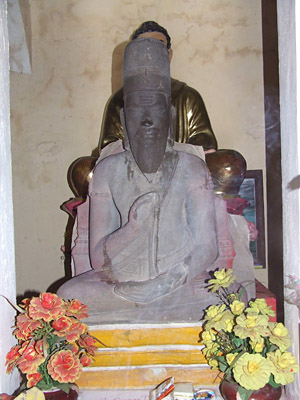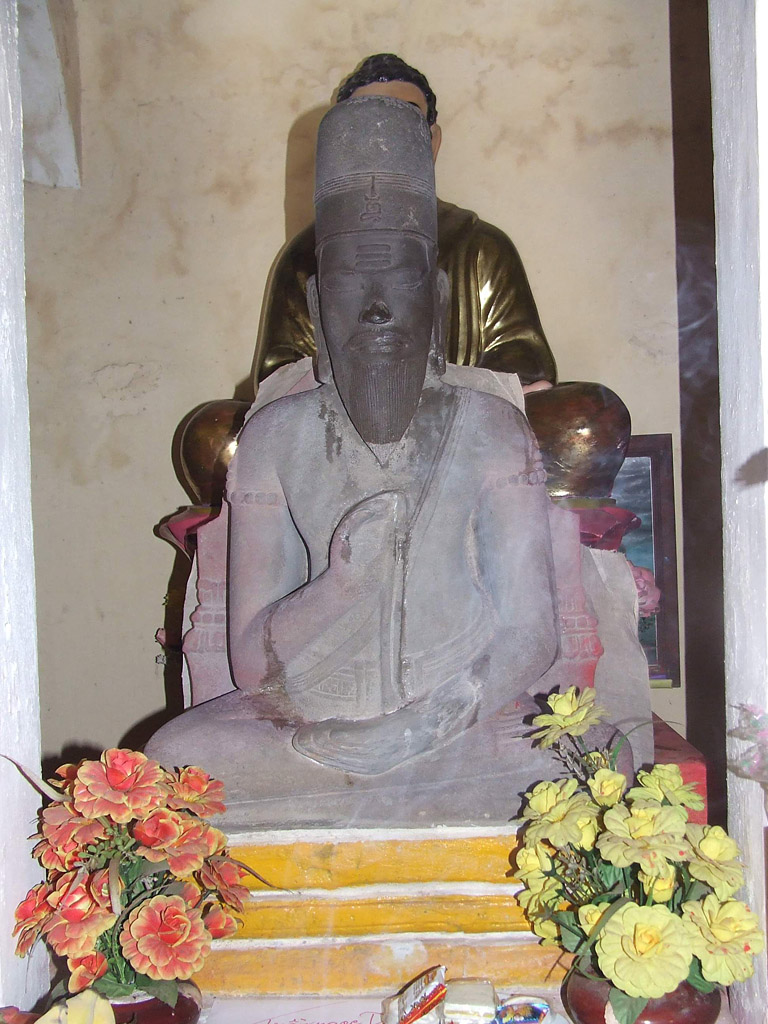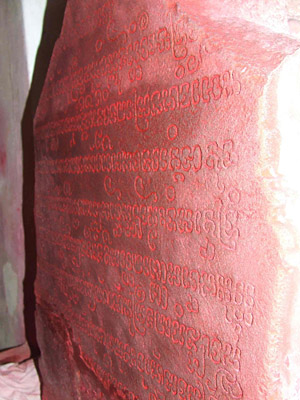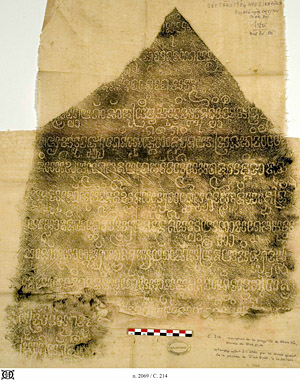Corpus of the Inscriptions of Campā






C. 214 Statue of a Śivācārya on the Nhơn Hải Peninsula
Please note: you are reviewing a preprint version of this publication. Contents here may change significantly in future versions. Scholars with specific interests are urged to consult all cited bibliography before using our texts and translations or drawing other significant conclusions.
Support Back of a sculptural stela of a Śivācārya;1 sandstone; h. ?? cm × w. ?? × d. ??.
Text Remains of twelve lines on one face written in Old Cam.
Date 1352 Śaka (1430/1 CE).
Origin Settlement of Phật Lồi Pagoda on Nhơn Hải peninsula (Bình Định, Vietnam).
This piece was found under unknown circumstances at the Phật Lồi Pagoda on Nhơn Hải peninsula, at at unnown date before the manufacture of the estampage held at the Musée Guimet, which appears to be decades old. We received the documents used here (photographs, made in 2005, as well as the inked estampage, made at an unknown date) from Đinh Bá Hòa, director of Bảo Tàng Tổng Hợp Bình Định (General Museum of Bình Định) in May 2011. Its inventory number was published in ECIC III.
Edition(s) Previously unpublished.
Facsimiles
- Estampage: Musée Guimet ???
- Estampage: EFEO n. 2069
The following text was edited by Arlo Griffiths.
(2) { ? }[p]u pom̃ tana rayā ya dṛ[m̃]{ ? }
(3) { ? }(na)(n·) dadam̃n· varṇna urām̃ aviḥ
(4) [|] svasti | yām̃ pom̃ ku śrī vṛṣu viṣṇujātti vīrabhadrava[rm](m)[ade-]
(5) va | bṛṣuvaṅṣa ādi pūra ṅgauk· glaum̃ vijaya | prathamāviśeka
(6) di śaka eka-loka-naya-rāma tam̃l· śaka rāja-aggi-vānu-ca-
(7) kṣu pu pom̃ ku kā rijan· dhvajakalpa paṇcākṣara klāḥ di pancedri-
(8) ya klāḥ di paṇcatāppa ṅan· rijan· śattayañña paṇcamakutta
(9) pu pom̃ ku kā imyam̃ mvoḥ vākya yām̃ pom̃ ku śrījayasiṅghavarmma-
(10) deva mayvā di rāja dudim̃ pu pom̃ ku kā mapunaḥ vumvom̃ pavvak· anva-
(11) k(·) vrim̃ adhyā vuḥ { ? } vuḥ (ha°i)n· humā { ? }
(12) (m)ram̃k· yām̃ nī ||
(om̐) ◇ the trace of a sign above line 1 is likely to have been the descending part of this invocation. — [|] ◇ space does not seem sufficient for a more substantial liminal sign, and comparison with the lay-out of C. 128 suggests that only a daṇḍa originally preceded svasti here. — 5 pūraṅgauk· glaum̃ vijaya ◇ cf. C. 43, face A, l. 3 pūra ṅauk glaum̃ vijaya. — prathamāviśeka ◇ understand prathamābhiṣeka (cf. C. 43, face A, l. 1-2 for the same spelling). Or pratimābhiṣeka (cf C. 42, l. 11)?. — 6 aggi ◇ understand agni. — 7-8 pancedriya ◇ I suppose that we must understand pañcendriya. — 10 kā mapunaḥ ◇ or analyze kāma punaḥ? Cf. C. 43, face A, l. 15 kā ma°udyāna (or kāma udyāna?). — 11 A few more akṣaras could probably be recovered here from the M. Guimet estampage.
Translation
... P.P.T.R. has assumed kingship ... various classes of all men.
Hail! His majesty Śrī Vṛṣu Viṣṇujāti Vīrabhadravarmadeva, [whose name] begins with Vṛṣuvaṁśa, [who hails from] the capital of Ṅauk Glauṅ Vijaya, who had his first royal consecration in Śaka one, (three) worlds, (four) policies, (three) Rāmas, (one) king (i.e. in 1343 Śaka): it came to pass (tam̃l) in Śaka (one) king, (three) fires, (five) arrows, (two) eyes (i.e. in 1352 Śaka) that milord performed a banner-ritual (?, dhvajakalpa) of the five-syllable (mantra) without the five senses, without the five penances and he performed a hundredfold-offering of five crowns. Milord then saw and realized (?, imyam̃ mvoḥ) the instruction (?, vākya) of his majesty Śrī Jayasiṁhavarmadeva to give protection to future kings. Milord then restored the sanctuary, pavvak an anvak, gave adhyā, offered ... this god.
Commentary
Secondary Bibliography
- ECIC III: 486.
- Đà Nẵng Catalog: ???.
Notes
- The shoulder of the back of the stela seem to have broken off, causing loss of text on lines 1-3.



With lines 4-5, cf. C. 57 l. 1-2: śrī vṛṣuvaṅśa viṣṇujātti vīrabhadravarmmadeva pu pom̃ ku ya ādināmma. In l. 9-10, it seems attractive to understand the sentence in the sense 'instruction to future kings to give protection'. On the expression pavvak anvak, which must denote some action with regard to some kind of strcuture, see Đà Nẵng Catalog: ???, on C. 43, face B, l. 3-4.